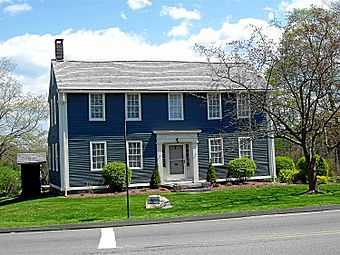William Williams House (Lebanon, Connecticut) facts for kids
|
William Williams House
|
|
|
U.S. Historic district
Contributing property |
|

William Williams House in 1968
|
|
| Location | Lebanon, Connecticut |
|---|---|
| Area | less than one acre |
| Built | by 1748 |
| Architectural style | Greek Revival |
| Part of | Lebanon Green Historic District (ID79002666) |
| NRHP reference No. | 71001012 |
Quick facts for kids Significant dates |
|
| Added to NRHP | November 11, 1971 |
| Designated NHL | November 11, 1971 |
| Designated CP | June 4, 1979 |
The William Williams House is a very old and important house in Lebanon, Connecticut. You can find it where two roads, Connecticut Routes 87 and 207, meet. This house is special because it was the home of William Williams from 1755 until he passed away in 1811.
William Williams was a very important person in American history. He was a representative for Connecticut in the Continental Congress. He also famously signed the United States Declaration of Independence, which declared America's freedom from Great Britain. The house itself is well-preserved and still looks much like it did long ago.
Contents
What the House Looks Like
The Williams house is a two-and-a-half-story building made of wood. It has a roof that slopes down on two sides and two chimneys inside. The outside walls are covered with overlapping wooden boards called clapboard siding.
The main front door is in the middle of the house. It has a fancy frame around it, with narrow windows on the sides and flat columns next to the door. A decorative top piece, called a cornice, sits above the door. A smaller, one-story part of the house extends from the back.
Inside, the house has a central hallway with rooms on both sides. Many original features are still there. These include the decorative frames around the fireplaces, even though most of the fireplaces are no longer used. The wide pine floors are also original.
William Williams' Story
We don't know exactly when the house was built or who owned it first. Reverend Solomon Williams bought it in 1748. He then gave it to his son, William, in 1755.
William Williams was born in 1731. He studied at Harvard College. In 1755, he served in the local army during the French and Indian War. That same year, he moved to Lebanon.
William Williams had a busy career. He worked as a merchant (someone who buys and sells goods), a judge, and a politician. He served in Connecticut's assembly (a type of government meeting) from 1757 to 1776. Later, he was in the state legislature from 1781 to 1784.
Supporting American Independence
William Williams strongly believed in America becoming independent from Great Britain. He worked closely with his father-in-law, Jonathan Trumbull, who was the Governor of Connecticut.
Williams even used his own money to help pay for Connecticut's soldiers. These soldiers were part of the group that captured Fort Ticonderoga in 1775. This was an important early victory in the American Revolution.
He was chosen to be a delegate to the Second Continental Congress. This is where he signed both the United States Declaration of Independence and the Articles of Confederation. The Articles of Confederation was the first agreement among the 13 original states. Later, in 1788, he was a delegate at the meeting where Connecticut agreed to the United States Constitution.
The House During the War
William Williams' house was also part of the war effort. In the winter of 1780-1781, French cavalry (soldiers on horseback) called Lauzun's Legion stayed in Lebanon. Williams' house was used to house Robert Dillon, who was Lauzun's second-in-command.
A National Historic Landmark
Because of its importance to American history, the William Williams House was named a National Historic Landmark in 1971. It was also added to the National Register of Historic Places that same year.



